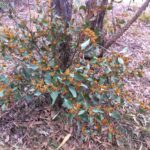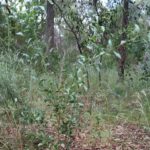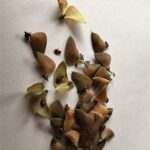Gardening with Indigenous Plants
Indigenous Plant Use
Identification & Control of Common Weeds
| Botanical Name: | Daviesia latifolia |
| Common Name: | hop bitter-pea |
| Sold As: | Tube ($2.00) |
| Plant Type(s): | Medium Shrub (1 to 2 m), Tall Shrub (2 to 6 m), Bird Attracting, Hedging |
| Growing Conditions: | Full Sun, Partial Shade
Dry, Well Drained |
| Size (HxW): | 3 m x 2 m |
| Foliage: | Leathery, blue-green elliptic to egg-shaped leaves 2-15 cm x 5-70 mm with network of prominent veins and wavy edges. |
| Flowers: | Many-flowered sprays of small fragrant yellow and brown pea flowers, with a distinct bract at the base of each stalk. Triangular pod. September-December |
| General Comments: | Useful for screening or hedge. Open to dense erect shrub with angular branchlets. Frost and snow tolerant. Can be pruned to shape. Leaves were used to replace hops by early settlers. |
 Further Information: |
|
| Plant Propagation: | Propagation is easy from seed following pre-treatment to break the physical dormancy provided by the impervious seed coat. Pre-treatment can be carried out by abrasion or by the use of boiling water (further details can be found in under the “Propagation” tab of the “Pea Family” page). The seed retains viability for many years. Cuttings may be successful but are often slow to strike and may not produce a vigorous root system. The pods turn brown and become brittle when ripe, and the seed turns from green to black. Seed drops very soon after maturity so pods must be collected before they split, usually 4-6 weeks after flowering. Monitor fruits closely, bag maturing fruits or place groundsheets under plants to catch seed (although ants also harvest the seed). Alternatively, the pods can be harvested close to maturity (when they turn light-brown and brittle, and rattle when shaken) and fully dried in a warm area. It may be difficult to obtain seed in useful quantities. |






